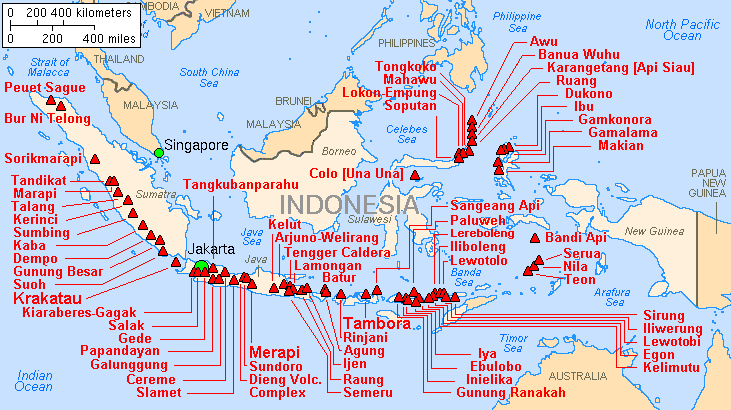MARCH 12, 2018
SHANNON HALL

Mount Sinabung erupts — Lake Toba Supervolcano now steaming +emitting foul odors of gas. June 8, 2015 Michael Janitch.

Major volcanoes of Indonesia, with eruptions since 1900 C.E. Lyn Topinka, USGS; base map from CIA, 1997; volcanoes from Simkin and Siebert, 1994


Lake Toba in Indonesia is serene today, but 74,000 years ago it was the site of the most powerful volcanic eruption to take place on Earth in the past two million years. Credit Lana Priatna/SOPA Images/LightRocket, via Getty Images.
Supervolcanoes have the power to cough up enough ash to coat entire continents. They emit waves of hot gas, rocks and ash that flow down their slopes at speeds so great they strip away vegetation and kill anyone in their path. And they carve vast depressions in the planet, leaving permanent scars.
And yet, they might not be as apocalyptic as previously thought. About 74,000 years ago, a supervolcano at the site of present-day Lake Toba on the Indonesian island of Sumatra rocked our world. But while it was the largest volcanic eruption of the last two million years, a new study published Monday in Nature suggests that humans not only survived the event — they thrived.
The study counters previous hypotheses, which suggested that the behemoth was so disastrous it caused the human species to teeter on the brink of extinction.

Archaeological excavations at a site on South Africa’s southern coast, where evidence of the Toba event was uncovered alongside ancient bones, stone tools and evidence of human fires. Credit Curtis W. Marean/Arizona State University.
It’s easy to see how that idea came about. The Toba supereruption expelled roughly 10,000 times more rock and ash than the 1980 Mount St. Helens eruption. So much ejecta would have darkened skies worldwide, causing scientists to speculate that it might have plunged the Earth into a volcanic winter whose chill could be felt far from Indonesia. Climate models suggest that temperatures may have plummeted by as much as 30 degrees Fahrenheit. And in such a cold world, plants may have ceased growing, glaciers may have advanced, sea-levels may have dropped and rainfall may have slowed.
Then in 1998, Stanley Ambrose, an anthropologist, linked the proposed disaster to genetic evidence that suggested a population bottleneck had occurred around the same time. He was certain that the Toba supereruption had caused the human population to decline to some 10,000 people — a close call for our ancestors.
“These were dramatic theories,” said Michael Petraglia, an archaeologist at the Max Planck Institute for the Science of Human History who was not involved in the study. “They were very popular — both in the scientific world, but also in the public imagination.”
The latest study, however, suggests that those theories are incorrect, Dr. Petraglia said. “We’re not seeing all the drama.”
More than 5,500 miles from the site of the Toba supereruption in Southeast Asia, Curtis Marean, an anthropologist at Arizona State University, and his colleagues discovered signs of its debris at two archaeological sites on South Africa’s southern coast. The appearance of microscopic glass shards once ejected by the Toba event amid layers of ancient bones, complex stone tools and evidence of human fires allowed the team to directly observe the volcano’s impact on the human population for the first time.
The results surprised Dr. Marean. Should Dr. Ambrose’s theory be correct, there would be fewer signs of human occupation in the layer of soil above the one with the signs of the Toba supereruption. Dr. Marean’s team saw the opposite: After the catastrophic event, there were more signs of human occupation. Not only did humans appear to adapt to the trauma caused by the event, they thrived, said Eugene Smith, an author of the study and a retired geologist.
That doesn’t mean Toba’s volcanic winter never occurred. Dr. Marean speculates that an ensuing global chill may have driven these prehistoric humans to the coast where they were able to survive.
But not all experts agree with that interpretation.
Although Dr. Petraglia praised Dr. Marean’s work, he said it did not buttress the case for a global climate catastrophe following the Toba eruption. He pointed to a study published this year [Journal of Human Evolution] of a similar ash layer within Lake Malawi in East Africa. There, scientists found no signs that the lake’s temperature dropped significantly after the event — suggesting that there was no volcanic winter, and further challenging the idea of a human population decline resulting from the Toba eruption.
And he’s not alone.
“I personally lean toward the idea that Toba just didn’t have sufficient impact to have a significant impact on Homo sapiens in East Africa, period,” says Thomas Johnson, a retired paleoclimatologist at the University of Minnesota, Duluth, who was not involved in the study. “The large majority of the information that keeps coming out keeps putting nails in the Toba coffin.”
See the full article here .
Please help promote STEM in your local schools.
